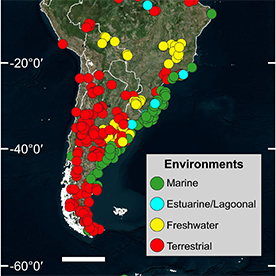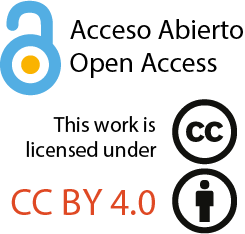THE RISE OF ACTUALISTIC TAPHONOMY IN SOUTH AMERICA
El crecimiento de la tafonomía actualista en Sudamérica
DOI:
https://doi.org/10.5710/PEAPA.24.07.2025.542Keywords:
Naturalistic studies, Experimental studies, Multidisciplinary, Environmental diversity, Geographical distributionAbstract
Over the past four decades, global actualistic taphonomy studies have grown significantly, driven by increased interest in present day patterns and processes of fossilization. South America has mirrored this trend, though the exact growth level is unclear. This study compiles actualistic taphonomy research in South America based on internationally accessible journal articles and book chapters using databases such as Web of Science, ResearchGate, Google Scholar, and Academia. Results revealed a steady rise in studies from 1985, with Argentina leading, followed by Brazil, Uruguay, and a few other countries with lesser representation. Terrestrial environments have seen the most extensive research, largely due to archaeologists and vertebrate paleontologists, with marine environments (mainly mollusk-based studies) following. Freshwater actualistic taphonomy began in 2006 and was the next most commonly represented, while estuarine and lagoonal environments were the least studied. Most research has been naturalistic: examining taphonomic patterns, taphofacies, live-dead fidelity, and time-averaging. However, experimental studies increased markedly after 2009. Synthesis papers appeared from 2007, reflecting the growing body of literature. Archaeological studies have been the most prolific, with vertebrate studies dominating the region’s actualistic taphonomy literature, followed by research on mollusks and lithics. Brachiopods, foraminifera, diatom, pollen, and phytoliths have developed less. Several groups, including plants, arthropods, worms, lichens, charcoal, pottery, rock art paintings, and sediments, remained poorly studied, highlighting the need for further research. This review underscores the significant progress made in South American actualistic taphonomy but also points to underrepresented environments and taxonomic groups that should be addressed in future studies.
References
Alunni, D. & Álvarez, M. C. (2017). Actualistic Taphonomy in Argentina: Current status of the research and future perspectives. Journal of Taphonomy, 15, 1-9.
Behrensmeyer, A. K. (2021). Taphonomy. En D. Alderton y S. A. Elias (Eds.), Encyclopedia of Geology, 2nd Edition (pp. 12–22). Academic Press. https://doi.org/10.1016/B978-0-08-102908-4.00120-X.
Behrensmeyer, A. K., Denys, C. & Brugal, J.-P. (2018). What is taphonomy and What is not? Historical Biology, 30: 718-719. https://doi.org/10.1080/08912963.2018.1432919
Beovide, L. & Martínez, S. (2014). Concheros arqueológicos en la costa uruguaya: revisión y perspectivas. Revista Chilena de Antropología, 29: 26-31.
Borrazzo, K. (2016). Lithic taphonomy in desert environments: Contributions from Fuego-Patagonia (Southern South America). Quaternary International, 422: 19-28.
Borrero, L. A. (1985). Taphonomic observations on Guanaco skeletons. Current Research in the Pleistocene, 2, 65-66.
Borrero, L. A. (2020). Taphonomy, Regional. In C. Smith (Ed.), Encyclopedia of Global Archaeology, 2nd Edition (pp. 10524–10527). Springer Nature Switzerland AG 2020.
Carroll, M., Kowalewski, M., Simões, M. G. & Goodfriend, G. A. (2003). Quantitative estimates of time-averaging in brachiopod shell accumulations from a modern tropical shelf. Paleobiology, 29:381-402, doi: 10.1666/0094-8373(2003)029<0381:QEOTIT>2.0.CO;2.
De Francesco, C. G., Tietze, E., Cristini, P. A. & Hassan, G. S. (2020). Actualistic taphonomy of freshwater mollusks from the Argentine Pampas: an overview of recent research progress. In S. A. Martínez, A. Rojas & F. Cabrera (Eds.), Actualistic Taphonomy in South America (pp. 69–88). Springer. Topics in Geobiology 48.
Dexter, T. A., Kaufman, D. S., Krause, R. A., Jr., Barbour Wood, S. L., Simões, M. G., Huntley, J. W., Yanes, Y., Romanek, C. S. & Kowalewski, M. (2014). A continuous multi-millennial record of surficial bivalve mollusk shells from the São Paulo Bight, Brazilian shelf. Quaternary Research, 81: 274–283, doi: 10.1016/j.yqres.2013.12.007.
Erthal, F., Kotzian, C. B. & Simões, M. G. (2011). Fidelity of molluscan assemblages from the Touro Passo Formation (Pleistocene–Holocene), southern Brazil: taphonomy as a tool for discovering natural baselines for freshwater communities. Palaios, 26: 433-446.
Gutiérrez, M. A., Rafuse, D. J., Álvarez, M. C., Massigoge, A., González, M., Scheifler, N. A. & Kaufmann, C. (2018). Ten years of actualistic taphonomic research in the Pampas region of Argentina: Contributions to regional archaeology. Quaternary International, 492: 40-52. https://doi.org/10.1016/j.quaint.2017.09.025
Hassan, G. S., De Francesco, C. G. & Díaz, M. C. (2020). Actualistic taphonomy of freshwater diatoms: Implications for the interpretation of the Holocene record in Pampean shallow lakes. In S. A. Martínez, A. Rojas y F. Cabrera (Eds.), Actualistic Taphonomy in South America (pp. 89–109). Springer. Topics in Geobiology 48.
Kidwell, S. K. & LaBarbera, M. (1993). Experimental taphonomy. Palaios, 8:1-2.
Kowalewski, M. & LaBarbera, M. (2004). Actualistic taphonomy: Death, decay, and disintegration in contemporary settings. Palaios, 19, 423-https://doi.org/10.1669/0883-1351(2004)019%3C0423:ATDDAD%3E2.0.CO;2
Kowalewski, M. & Rothfus, T. A. (2012). Death and disintegration in Bahamas: taphonomic patterns and processes in tropical island settings. Palaios, 27: 123-126. https://doi.org/10.2110/palo.2012.SO2
Krause JR., R. A., Barbour, S. L., Kowalewski, M., Kaufman, D. S., Romanek, C. S., Simões, M. G. & Wehmiller, J. F. (2010). Quantitative comparisons and models of time-averaging in bivalve and brachiopod shell accumulations. Paleobiology, 36: 428-452, doi: 10.1666/08072.1.
Martínez, S., Rojas, A. & Cabrera, F., eds. (2020). Actualistic taphonomy in South America. Springer. Topics in Geobiology 48.
Marean, C. (1995). Of Taphonomy and Zooarchaeology. Evolutionary Anthropology, 4 (2): 64-72, doi: http://dx.doi.org/10.1002/evan.1360040209
Mondini, M. (2018). Carnivore taphonomy in South America: a review of actualistic studies and their implications in the southern Neotropics. Historical Biology, 30: 774-785. https://doi.org/10.1080/08912963.2017.1319831
Mondini, M. & Muñoz, A. S. (2008). Pumas as taphonomic agents: A comparative analysis of actualistic studies in the Neotropics. Quaternary International, 180: 52-62. https://doi.org/10.1016/j.quaint.2007.08.013
Montalvo, C. I. & Fernández, F. J. (2019). Review of the actualistic taphonomy of small mammals ingested by South American predators. Its importance in the interpretation of the fossil record. Publicación Electrónica de la Asociación Paleontológica Argentina, 19: 18-46. https://doi.org/10.5710/PEAPA.11.03.2019.275
Parsons-Hubbard, K. M., Brett, C. E. & Walker, S. E. (2011). Taphonomic field experiments and the role of the Shelf and Slope Experimental Taphonomy Initiative. Palaeogeography, Palaeoclimatology, Palaeoecology, 312, 195-208. http://dx.doi.org/10.1016/j.palaeo.2011.11.009
Ritter, M. N., Erthal, F., Horodyski, R. S. (2023). The present is the key to the past: Actualistic taphonomy in South America. Palaios, 38: 109-110. https://doi.org/10.2110/palo.2023.008
Ritter, M. N., De Francesco, C. G., Erthal, F., Hassan, G. S., Tietze, E. & Martínez, S. A. (2016). Manifesto of the South American School of (Actualistic) Taphonomy. Palaios, 31: 20-24. http://dx.doi.org/10.2110/palo.2015.065
Ritter, M. N., Erthal, F., Kosnik, M. A., Coimbra, J. C. & Kaufman, D. S. (2017). Spatial variation in the temporal resolution of subtropical shallow-water molluscan death assemblages. Palaios, 32: 559-571, https://doi.org/10.2110/palo.2017.003
Ritter, M. N., Erthal, F., Kosnik, M. A., Kowalewski, M., Coimbra, J. C., Caron, F. & Kaufman, D. S. (2023). Onshore-offshore trends in the temporal resolution of molluscan death assemblages: how age-frequency distributions reveal quaternary sea-level history. Palaios, 38:148-157, https://doi.org/10.2110/palo.2021.041
Rojas, A. & Martínez, S. (2020). The fossil, the dead, the living: beach death assemblages and molluscan biogeography of the Uruguayan coast. In S. A. Martínez, A. Rojas y F. Cabrera (Eds.), Actualistic Taphonomy in South America (pp. 17–34). Springer. Topics in Geobiology 48.
Simões, M. G., Rodrigues, S. C. & Kowalewski, M. (2009). Bouchardia rosea, a vanishing brachiopod species of the Brazilian platform: taphonomy, historical ecology and conservation paleobiology. Historical Biology, 21: 123-137.

Additional Files
Published
Issue
Section
License
Copyright (c) 2025 Claudio Germán De Francesco, Fernando Miguel Archuby, Karen Borrazzo, Luis Alberto Borrero, María A. Gutiérrez, Gabriela S. Hassan, Sergio Agustín Martínez, Claudia Inés Montalvo, Matias do Nascimento Ritter

This work is licensed under a Creative Commons Attribution-NoDerivatives 4.0 International License.
Authors retain copyright and grant the journal right of first publication with the work simultaneously licensed under a Atribución/Reconocimiento 4.0 Internacional that allows others to share the work with an acknowledgement of the work's authorship and initial publication in this journal.















